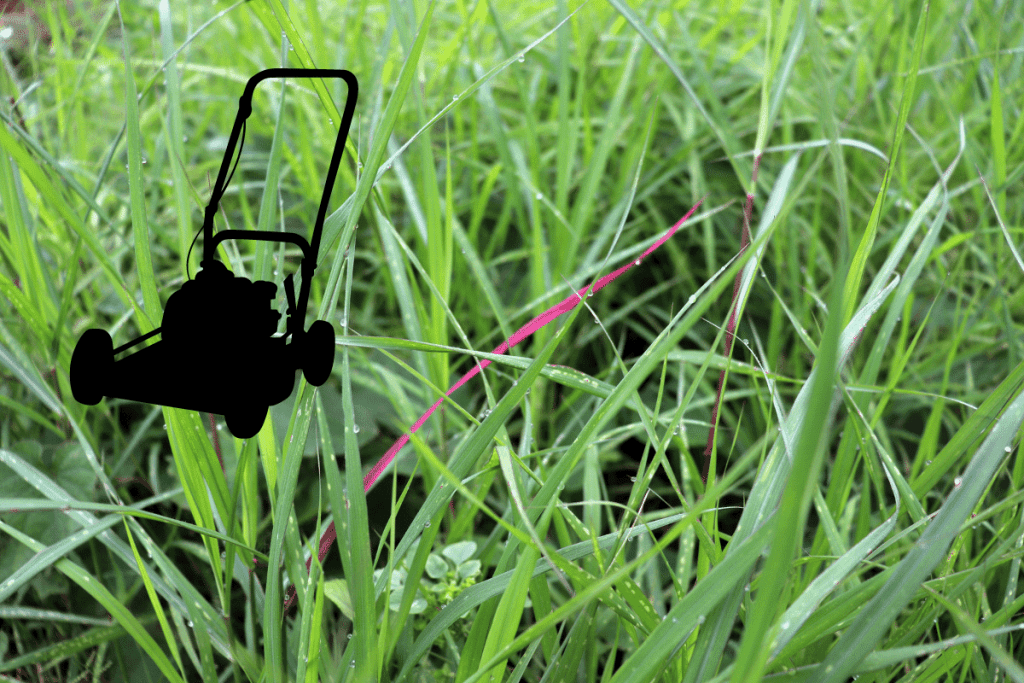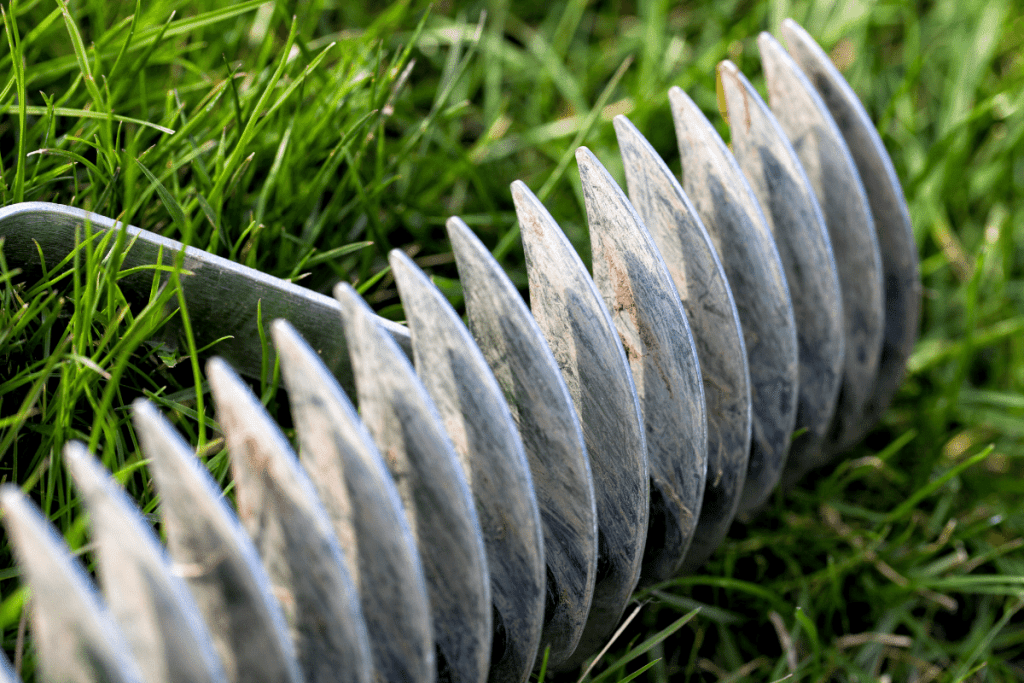If you’re aiming to have a pristine, healthy lawn, you’ve probably considered (or already are) dethatching at some point.
Removing thatch helps to aerate the soil, and there are many different products on the market designed for dethatching, including dethatching blades for lawnmowers.
But do they work, and are they worth your time and money?
Dethatching blades are only recommended for small lawns with very minimal thatch, while a dethatcher tool (like a power rake) is best for larger yards with heavy thatch. Dethatching blades are not as fast or efficient as other dethatching tools, and if misused, they will damage your lawn.
Read on to learn more about removing thatch, dethatching blades, how they work, and the types of dethatching blades on the market you have to choose from.
Although dethatching blades have a very niche use, they are great for folks with small yards with only a small amount of thatch to deal with.

Table of Contents
What Is Thatch?
Before we learn more about the different types of dethatcher blades and how they are used, it helps first to understand what thatch is and why it’s so important to remove it from your lawn every so often.
Essentially, your lawn comprises four separate layers: the dense, compacted soil layer at the bottom, then a thatch layer above it, and then the crown of the grass and the exposed grass blades at the very top.
If you were to pull up a small cross-section of the grass in your yard, you’d be able to see where each of these four layers begin and end.
Thatch is just a mixture of plant matter, both alive and dead, such as:
- Grass
- Roots
- Twigs
- Stems
- Other Random Organic Material
Over time, it builds up between the soil layer and the grass itself, and if too much of it becomes heavily compacted, the thatch will prevent proper drainage and aeration the soil needs.
While a small amount of thatch is acceptable and even promotes plant growth, large amounts of it are incredibly damaging.
If the thatch in your yard is left untreated, your lawn will start to look dry and dull, and any grass and other plants you have growing will begin to die off slowly.
Thatch buildup also is an ideal environment for damaging insects, lawn diseases, and various types of fungal growth, which will leave your lawn even more vulnerable.
While a ½” inches or so layer of thatch is standard, it should never grow to more than 1” inch in height.
If you have more than 1” inch of thatch buildup in your yard, it’s probably time to dethatch either with a dedicated tool like a power rake or dethatching blades, which are a lawnmower attachment.
If you leave the thatch to continue building up beyond 1” inch in height, your soil will become heavily dense, hard, and compacted.
If your soil goes without proper drainage or aeration for extended periods, your entire lawn is at risk, from grass to flowers to crops and other plants.
The plants’ roots won’t access the vital nutrients and oxygen they need to thrive.
What Are Dethatching Blades?

Dethatching blades are uniquely designed lawnmower blades that are meant to be attached to your mower to turn into a temporary dethatching tool.
They are one of the best dethatching options for small lawns with minimal thatch buildup of around 1” inch or less.
They are not ideal for deep dethatching.
While regular lawn mower blades are flat and meant to trim grass, mower dethatching blades are different.
Similar to an actual dethatching tool, the blades have spikes or tines pointing outward from the blade, which dig down into the thatch layer and pull it up, in turn aerating the soil and promoting proper drainage.
Not all dethatching blades are alike, however!
One very common type of blade isn’t practical for every kind of yard and will heavily damage your yard if you use it.
Let’s explore the different types of dethatching blades meant to be attached to your lawnmower and why it’s so important to use the correct type.
Types Of Dethatching Blades
There are two main types of dethatching blades on the market: metal spring attachments and nylon trimmer line attachments.
If you’re looking into buying dethatching blades for your mower, we highly recommend opting for blades with metal spring attachments.
These are far more effective and durable than blades with nylon trimmer lines.
The majority of dethatching blades are designed to be used with 20”-inch lawn mowers (which is another reason why they’re best used on small yards), but some manufacturers have different sizes available.
Blades with metal spring attachments are great for removing very light thatch (anywhere from ½” inches to 1” inch of buildup) from fairly small yards.
However, if they are used on heavy thatch buildup, you run the risk of damaging both your yard and the dethatching blade itself.
On the other hand, nylon trimmer line blades are unable to differentiate from thatch and healthy grass.
They will indiscriminately tear up anything it comes across, in turn doing far more damage to your yard than the thatch buildup did in the first place!
How Do You Use Dethatching Blades?
One key benefit of using dethatching blades is how simple they are to attach to your mower and use.
To get started, just swap out your existing standard lawnmower blade for the dethatching blade.
Make sure you’ve purchased a dethatching blade with metal spring attachments rather than one with nylon trimmer lines!
Next, go ahead and adjust the height of the mower to its tallest setting.
You’ll be able to adjust it to better fit your yard and thatch layer soon, but for now, leave it as high as it’ll go.
Go over a small patch of your yard while the mower is set to its tallest setting.
Take a look at the test patch afterward and start adjusting the height a bit lower; you’ll be able to tell the blade is set to the proper height when the thatch layer is cleanly removed, but the healthy grass layer on top is left untouched.
Once you’ve adjusted the blade to a more appropriate height, go over larger sections of your lawn.
Check the blade and your yard periodically to ensure it removes the thatch properly, as you’ll likely need to slightly adjust the mower height occasionally.
You’ll also need to take a close look at the dethatching tines/spikes themselves every so often to ensure they haven’t been damaged or bent; if they become damaged, they’ll need to be replaced, as they will no longer be able to dethatch your lawn efficiently.
While dethatching blades are simple to use and set up, there is also a fair amount of room for error if they aren’t used correctly.
This is also why they are meant for a very specific type of yard and thatch buildup, as they simply aren’t designed to take on large yards with excessive thatch.
Finally, always make sure you always wear safe clothing/equipment while operating your dethatching blades, like eye protection and long sleeves, and long pants.
If the dethatching blade goes over hard debris like rocks, tough plastic debris, or branches, there’s a chance the blade will eject them at high speeds.
Do Dethatching Blades Work?
Yes, dethatching blades remove small amounts of thatch from small yards of around 4,000’ square feet or less.
They are not designed for large yards with heavy amounts of thatch buildup, as the blades just aren’t powerful enough to remove heavily compacted thatch.
In addition, it’s crucial to be sure you purchase the correct type of dethatching blade.
Only purchase dethatching blades with metal spring attachments, as they are far more effective, durable, and can better discriminate between healthy grass and actual thatch.
Don’t waste your time with nylon trimmer attachment blades, as these will do more damage to your yard and end up destroying the healthy living grass along with ripping up the thatch.
If you don’t want to clean up a huge mess and end up paying a pretty penny to replace the damaged grass, avoid these types of blades at all costs.
Are Dethatching Blades Worth Buying?
Whether or not dethatching blades are worth buying depends heavily on your yard, its size, how much storage space you have, and the extent of the thatch buildup in your yard.
As we touched on earlier, these lawnmower attachments are designed for a very specific type of yard: small yards of around 4,000’ square feet or less with thatch buildup of less than 1” inch.
If you have a larger yard with a more serious thatch problem, a dethatching blade won’t be able to tackle it; you’ll need something more effective, like one of the many types of dethatching rakes on the market.
Additionally, if you don’t have much storage space like a dedicated shed to store your lawn tools, a dethatching blade is a good idea because it doesn’t take up much space.
While other dethatching tools are large and unwieldy, dethatching blades are quite small and compact.
Opt for dethatching blades if your yard is small and doesn’t have much thatch to remove.
Alternatively, you have the option of renting a dethatching blade a few times a year if your lawn is especially small and you don’t need to aerate and dethatch it very often.
If you’re not interested in committing to purchasing one of these blades, renting is a great choice.
In the end, it’s up to you to decide if a dethatching blade or something more heavy-duty like a power rake is right for you, but hopefully, you now have the information you need to make the right choice!